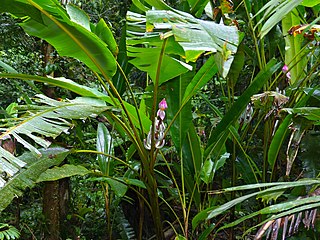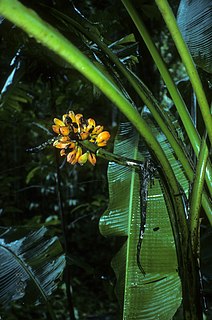
Musa ibn Nusayr served as a Umayyad governor and an Arab general under the Umayyad caliph Al-Walid I. He ruled over the Muslim provinces of North Africa (Ifriqiya), and directed the Islamic conquest of the Visigothic Kingdom in Hispania.

Musa is one of two or three genera in the family Musaceae. The genus includes flowering plants producing edible bananas and plantains. Around 70 species of Musa are known, with a broad variety of uses.

Nepenthes × bauensis is a natural hybrid involving N. gracilis and N. northiana.
Musa maclayi is a species of seeded banana native to Papua New Guinea and possibly the Solomon Islands. It is placed in section Callimusa. It is regarded as one of the progenitors of the Fe'i banana cultivars.
Musa tuberculata is a tropical Asian species of plant in the banana family native to the Malesian region (Brunei). It is one of fourteen species of Musa endemic to the island of Borneo. The specific epithet "tuberculata" is from the Latin meaning "covered with minute tubercles". M. tuberculata is placed in section Callimusa, members of which have a diploid chromosome number of 2n = 20.
Musa salaccensis, commonly called Javanese wild banana, is a Malesian tropical species of plant in the banana family native to the islands of Sumatra and Java, in Indonesia. It is placed in section Callimusa, members of which have a diploid chromosome number of 2n = 20.
Musa insularimontana is a species of plant in the banana family native to Taiwan, where it is known by the name lan yu ba jiao. It is placed in section Callimusa, having a diploid chromosome number of 2n = 20.

Fe'i bananas are cultivated plants in the genus Musa, used mainly for their fruit. Unlike most other cultivated bananas they are diploids of the AA-type. They are distinct in appearance and origin from the majority of bananas and plantains currently grown. Found mainly in the islands of the Pacific, particularly French Polynesia, Fe'i bananas have skins which are brilliant orange to red in colour with yellow or orange flesh inside. They are usually eaten cooked and have been an important food for Pacific Islanders, moving with them as they migrated across the ocean. Most are high in beta-carotene.
Musa hirta is a tropical Asian species of plant in the banana family native to Sarawak on the island of Borneo, in Malaysia. It is one of fourteen species of Musa endemic to the island of Borneo. It is placed in section Callimusa, having a diploid chromosome number of 2n = 20.

Musa coccinea, commonly known as scarlet banana or red-flowering banana, is a species of flowering plant in the banana and plantain family Musaceae, native to tropical China and Vietnam. It is a bat-pollinated evergreen perennial, placed in section Callimusa, having a diploid chromosome number of 2n = 20.
Musa bukensis is a species of wild banana from the Solomon Islands. It is placed in section Callimusa, having a diploid chromosome number of 2n = 20.
Musa jackeyi is a species of wild banana. It is placed in section Callimusa. It has only a small native range in north-east Queensland, Australia. It resembles the cultivated bananas called "fe'i" or "fehi", having an upright rather than a drooping fruit stalk, with the green terminal bud pointing upwards, and sap which is reddish in colour.
Musa barioensis is a species of wild banana, native to Sarawak, Malaysia. It is placed in section Callimusa, having a diploid chromosome number of 2n = 20.
Musa borneensis is a species of wild banana, native to the island of Borneo, in the Malaysian states of Sabah and Sarawak. It is placed in section Callimusa, having a diploid chromosome number of 2n = 20.

Musa campestris is a species of wild banana, native to the island of Borneo, in the Malaysian states of Sabah and Sarawak. It is placed in section Callimusa, having a diploid chromosome number of 2n = 20.
Musa fitzalanii is a species of wild banana, which was native to north-east Queensland, Australia, but is now believed to be extinct. The type specimen was collected in the 19th century, from the vicinity of 'Daintree's River'. Along with M. acuminata and M. jackeyi, it was one of the three species native to Australia. It was placed in section Callimusa.
Musa johnsii is a species of wild banana, native to western New Guinea. It is placed in section Callimusa, having a diploid chromosome number of 2n = 20.
Musa lawitiensis is a species of wild banana, native to the island of Borneo. It is placed in section Callimusa, having a diploid chromosome number of 2n = 20.

Musa lolodensis is a species of wild banana, occurring naturally from the Moluccas through to New Guinea. It is placed in section Callimusa, having a diploid chromosome number of 2n = 20. It is one of the possible parents of the cultivated Fe'i bananas.
Musa viridis is a species of wild banana, native to northern Vietnam. It is placed in section Callimusa, members of which have a diploid chromosome number of 2n = 20.






